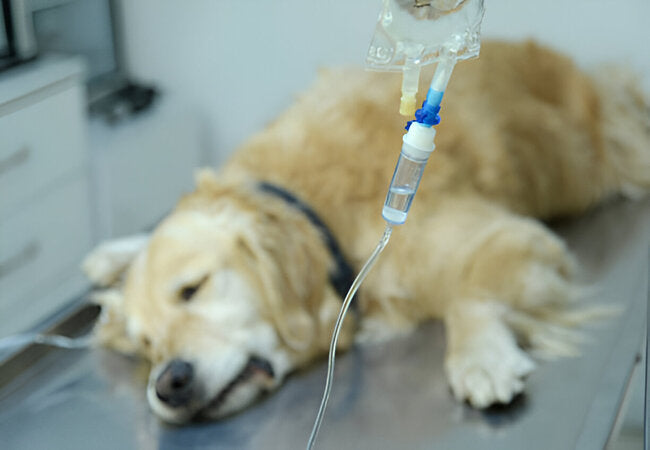Pleural Effusion in Dogs: 2025 Vet-Approved Treatment Guide 🐕💧

In this article
Pleural Effusion in Dogs: Signs, Causes & Treatment Guide 💧
By Dr. Duncan Houston BVSc
Hello—I’m Dr Duncan Houston BVSc, veterinarian and Ask A Vet founder. Pleural effusion—fluid collecting between your dog’s lungs and chest wall—is a critical condition that compresses the lungs and impairs breathing. Here’s everything you need to know:
- ✅ What pleural effusion is and why it happens
- 🩺 Recognizing the warning signs
- 🔍 Diagnostic approach: thoracentesis, imaging, fluid analysis
- 🛠 Treatment options and long-term care
- 🏠 At-home support using Ask A Vet, Woopf & Purrz tools
1. What Is Pleural Effusion?
Pleural effusion is the accumulation of fluid in the pleural space—the cavity between the lungs and chest wall—placing pressure on the lungs and making breathing difficult.
2. Warning Signs to Watch
- Rapid, shallow breathing (>30 breaths/min at rest)
- Labored breathing, open-mouth panting, extended neck, abdominal effort
- Coughing and exercise intolerance
- Restlessness and inability to lie comfortably
- Blue/pale gums (cyanosis), lethargy, decreased appetite
3. Common Underlying Causes
- Heart disease (CHF) – impairs fluid regulation
- Infections (pyothorax) – bacterial fluid in the chest
- Cancer – tumors in the chest or lungs
- Trauma or hemorrhage – includes rodenticide or chest injury (hemothorax)
- Chylothorax – lymphatic fluid leakage
- Diaphragmatic hernia, lung lobe torsion, pulmonary embolism, low proteins levels
4. Diagnosing Pleural Effusion
- Physical exam: muffled chest sounds, pale gums, fast breathing
- Chest X‑rays or focused ultrasound (POCUS) to detect fluid
- Thoracentesis: draining chest fluid for relief & analysis
- Fluid analysis: distinguish transudate, exudate, hemorrhagic, chylous, or neoplastic
- Bloodwork, ECG, echocardiogram for underlying condition investigation
5. Treatment & Management
5.1 Emergency Relief
- Thoracentesis provides immediate breathing relief
- Oxygen therapy stabilizes breathing
- Chest tube may be placed for repeated fluid removal
5.2 Treating the Cause
- Heart failure: diuretics (e.g., furosemide), ACE inhibitors, salt restriction
- Infection: antibiotics + drainage or chest tube for pyothorax
- Cancer: periodic drainage, chemotherapy, surgery, or palliative care
- Hemorrhage: treat bleeding disorders, transfusion if needed
- Chylothorax: thoracic duct ligation, low-fat diet, recurrent drainage
- Anatomical issues: surgical repair for diaphragmatic hernia or lung torsion
6. Prognosis & Monitoring
Prognosis depends on the underlying cause and how quickly the fluid is addressed. Chronic conditions like heart disease or cancer often need long-term management.
- Regular rechecks with imaging and bloodwork
- Home monitoring: respiratory rate, energy levels, appetite, and weight
- Adjust treatments or the intervention plan as needed
7. At‑Home Care & Support Tools
- Ask A Vet App: Remote check-ins, oxygen needs, breathing changes, treatment adjustments
- Woopf Puzzle Feeders: Gentle mental enrichment when exercise is limited
- Purrz Calming Mats: Comfortable resting support during recovery or illness
- Ensure a calm environment, avoid excitement, monitor water intake, and diet
8. Vet Case Example
Case: “Lucy,” a 6‑year‑old Labrador Retriever
Lucy presented acutely with coughing, panting, and pale gums. X‑rays confirmed fluid buildup. Thoracentesis drained 400 mL of modified transudate. Subsequent echo revealed early mitral valve disease. She was started on furosemide and ACE inhibitors, with daily respiratory rate monitoring at home via Ask A Vet. She now lives comfortably with annual imaging and management. Woopf feeders keep her calm, and Purrz mats ease her rest.
9. FAQs
- Is pleural effusion always life-threatening? Yes—any breathing difficulty is an emergency. Quick intervention significantly improves outcomes.
- Will the fluid return after drainage? Often yes, especially without treating the underlying cause. Ongoing care is key .
- Can small effusions resolve on their own? No—the fluid needs drainage, even in mild cases, to prevent lung collapse.
📌 Final Thoughts from a Vet
Pleural effusion is a serious condition requiring immediate veterinary attention, accurate diagnosis, and targeted treatment of the underlying cause. Long-term management often involves medications and monitoring. Supportive tools—Ask A Vet telehealth, calm enrichment with Woopf, and cozy comfort from Purrz mats—can improve your dog’s quality of life through recovery. If your dog shows breathing trouble or lethargy, don't delay—seek veterinary care right away. 🐾❤️






